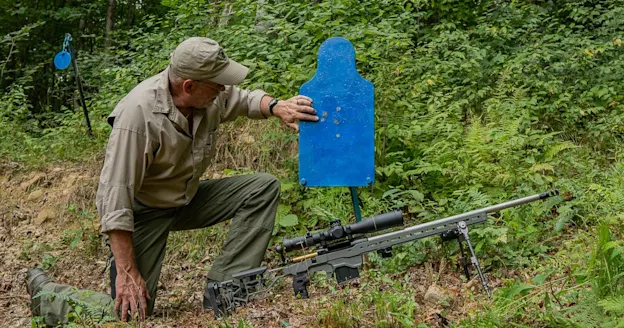_We may earn revenue from the products available on this page and participate in affiliate programs. Learn more ›
_
The Long Game is a new series designed to improve your long-range-shooting skills. This story is the twelfth, and final, installment.
We’ve finally reached the last part in this series on long-range marksmanship which culminates with shooting 1000 yards. As you extend the distance past 500 yards the best tool you can now add to your kit is an assistant—a friend or fellow long-range shooter —commonly referred to as a spotter. For the best results when shooting 1,000 yards you must—to the degree possible—separate yourself from the job of finding the firing solution and simply become the person behind the trigger. Your concentration should now be equally divided between establishing proper sight alignment, controlling your breathing, and pressing the trigger, without imparting any movement to the rifle or stress into your shooting platform.
Shooting 1,000 Yards with a Spotter
Can you get hits when shooting 1,000 yards without a spotter? Sure, but it’s twice as hard.
A spotter will range the target. While you’re concentrating on position refinement, they’ll be focused on reading the wind at 100 yards, 200 yards, 300 yards, and all the way to the target. The spotter will then provide you a firing solution, or, at a minimum, offer a wind read so that you can consult your DOPE and your ballistics program to apply the correct firing solution to the riflescope.
A spotter also often can observe the bullet trace as it flies downrange. This allows them to modify their original wind call as they observe bullet splash. This is especially true in the case of a complete miss. A good spotter can then take what they see of the bullet flight path or splash, and instantly provide you a correction before a major shift in wind direction, speed, or both occur.
Speak the Language
Without a spotter the shooter must do everything on their own and the task can become overwhelming, especially if the goal is to hit a target no larger than a foot in diameter, which leaves little room for error. Just as with shooting from 100 to 500 yards, you need a standardized shot process. When shooting 1,000 yards with the help of a spotter, it could look something like this:
Shooter and Spotter: Establish conditions and consult DOPE.
Spotter: Establish position, confirm with, “Spotter ready.”
Shooter: Establish position, verify with, “Standing by.”
Spotter: Identify target and guide shooter.
Shooter: Confirms target with, “Target identified.”
Spotter: Range target, provide distance or elevation correction.
Shooter: Apply solution, confirming with, “Shooter ready.”
Spotter: Read wind, provide speed and value, or the firing solution.
Shooter: Apply solution, confirming with, “Shooter ready.”
Spotter: Confirms wind remains unchanged with, “Send it.”
Shooter: Breathing, reticle focus, respiratory pause, trigger press, and follow-through.
Shooter: Cycles rifle action.
Spotter: Provides target call*
Shooter: Makes correction—typically using the reticle—based on spotter’s call.
Shooter: Announces, “Shooter ready.”
Spotter: Confirms wind remains unchanged with, “Send it.”
Shooter and Spotter: Repeat steps 11 through 16 until the desired impact is obtained.
*The spotter’s target call could be “lost” if he did not see impact, or “impact” if the target was hit. Otherwise, the call could be an adjustment only, such as, “up point five MOA” or “left one MIL.” If the target call is a correction, that’s the same as the spotter saying, “Send it.”
There’s no set dialogue for communication between a shooter and a spotter, but they should be a team who work together frequently—maybe developing their own unique methods and communication style.
DOPE for Shooting 1,000 Yards
It’s now imperative to confirm your DOPE in 100-yard increments from 500 to 1,000 yards. This not only gives you confidence in your gear, but also helps you refine the shot process and develop your skill. Spotters can help with this too. If you don’t have a spotter, you’ll just have to work extra hard at expertly performing everything you did to get hits at 500 yards.
Wind—One More Time
One of the most practical aspects of shooting at extreme distance is not to attempt it when the conditions are poor. Just like you would not go prairie dog hunting during a driving rainstorm or predator calling in gale force winds, when range winds are diabolically shifting, exceeding 20 mph and gusting, it’s a bad time to shoot. Yeah, you might get hits, but your data will only be applicable to that day, and about the only thing you’ll learn is that you should have stayed home.
Being able to place a bullet on a target the size of a sheet of notebook paper at 1,000 yards is very rewarding and makes you a member of an elite club. It takes a lot of practice and a lot of good gear to consistently perform at 1,000 yards. Just remember, the journey from 100.
Previous Installments in The Long Game
Part 2: Why You Need a Ballistics Calculator for Long Range Shooting
Part 5: How to Select the Best Rifle Scope for Long Range Shooting
Part 6: What to Look for in Rifle Bipods and Other Shooting Accessories
Part 7: Tips on Finding the Best Ammo for Long Range Shooting
Part 8: How to Master the Prone Position
Part 9: How to Zero a Long Range Rifle
Part 11: How to Shoot Out to 500 Yards






